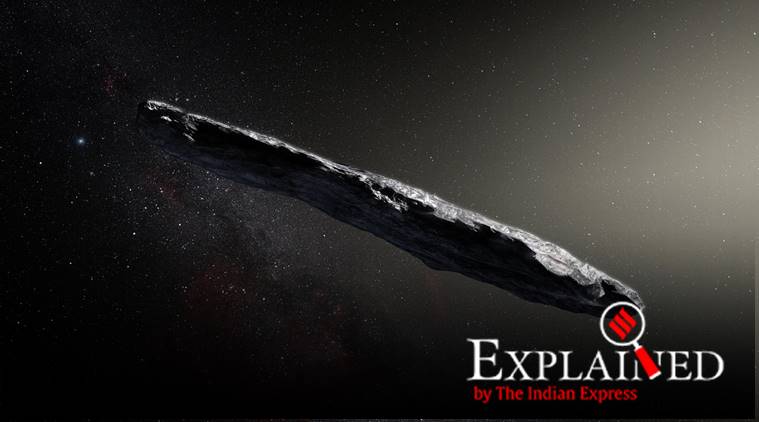Explained: Is a new interstellar object visiting Solar System?
On August 30, the MARGO observatory in Crimea spotted a comet which, astronomers believe, is likely to have originated from outside the Solar System, although the official confirmation has not been made yet.
 An artist’s concept of interstellar asteroid 1I/2017 U1 (‘Oumuamua) as it passed through the solar system after its discovery in October 2017. Observations of ‘Oumuamua indicate that it must be very elongated because of its dramatic variations in brightness as it tumbled through space. (Photo: European Southern Observatory/M. Kornmesser)
An artist’s concept of interstellar asteroid 1I/2017 U1 (‘Oumuamua) as it passed through the solar system after its discovery in October 2017. Observations of ‘Oumuamua indicate that it must be very elongated because of its dramatic variations in brightness as it tumbled through space. (Photo: European Southern Observatory/M. Kornmesser)
In October 2017, the Haleakala Observatory in Hawaii spotted a strange, spaceship-shaped object passing through the Solar System. Later named ‘Oumuamua, it became the subject of speculation whether it was really an alien spaceship, but was eventually declared by scientists to be an interstellar object — the first such known visitor to the Solar System.
Now, it appears that a second interstellar object is paying a visit. On August 30, the MARGO observatory in Crimea spotted a comet which, astronomers believe, is likely to have originated from outside the Solar System, although the official confirmation has not been made yet.
The comet has been designated C/2019 Q4 (Borisov). It is still inbound toward the Sun. It will remain farther from Earth than the orbit of Mars — it will approach no closer to Earth than about 300 million km, NASA’s Jet Propulsion Laboratory (JPL) said in a statement.
After the initial detections of the comet, JPL’s Scout system automatically flagged the object as possibly being interstellar. Scientists at NASA’s Center for Near-Earth Object Studies at JPL, European Space Agency’s Near-Earth Object Coordination Centre, and the NASA-sponsored Minor Planet Center in Massachusetts estimated the comet’s precise trajectory and determine whether it originated within the Solar System or came from elsewhere in the galaxy.
“The comet’s current velocity is high, about 150,000 kph, which is well above the typical velocities of objects orbiting the Sun at that distance. The high velocity indicates not only that the object likely originated from outside our Solar System, but also that it will leave and head back to interstellar space,” David Farnocchia of NASA’s Center for Near-Earth Object Studies said in the JPL statement.
As of Thursday, the comet was 420 million km from the Sun. It is heading toward the inner Solar System. On October 26, it will pass through the ecliptic plane — the plane in which Earth and the other planets orbit the Sun — from above at roughly a 40° angle. The comet will reach its closest point to Earth, or perihelion, on December 8.
C/2019 Q4 can be seen with professional telescopes for months to come. “The object will peak in brightness in mid-December and continue to be observable with moderate-size telescopes until April 2020. After that, it will only be observable with larger professional telescopes through October 2020,” Farnocchia said.
- 01
- 02
- 03
- 04
- 05






































